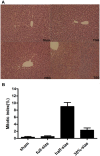Suppression of graft regeneration, not ischemia/reperfusion injury, is the primary cause of small-for-size syndrome after partial liver transplantation in mice
- PMID: 24709852
- PMCID: PMC3977924
- DOI: 10.1371/journal.pone.0093636
Suppression of graft regeneration, not ischemia/reperfusion injury, is the primary cause of small-for-size syndrome after partial liver transplantation in mice
Abstract
Background: Ischemia/reperfusion injury (IRI) is commonly considered to play a crucial role in the pathogenesis of small-for-size syndrome (SFSS) after liver transplantation. Rapid regeneration is also considered essential for the survival of SFS grafts.
Methods: Mouse models of full-size orthotopic liver transplantation, 50% partial liver transplantation and 30% partial liver transplantation were established. Survival rate and serum alanine aminotransferase were observed. IRI was assessed by hepatic pathologic alterations, apoptosis and necrosis. Regeneration response was detected by mitotic index, BrdU incorporation and PCNA, Cyclin D1 and Cyclin E expression. The expression of mTOR, AKT, ERK, JNK2 and p70S6K, also involved in regeneration signaling pathways, were analyzed as well.
Results: 30% partial liver graft resulted in a significantly low 7-day survival rate (P = 0.002) with no marked difference in tissue injury compared with the 50% partial graft group. Serum alanine aminotransferase levels were not significantly different between partial transplantation and full-size transplantation. Western blot analysis of caspase-3 and TUNEL staining also indicated no significant difference in apoptosis response between 30% partial transplantation and half-size or full-size transplantation (P = 0.436, P = 0.113, respectively). However, liver regeneration response indicators, mitotic index (P<0.0001) and BrdU (P = 0.0022), were markedly lower in 30% LTx compared with 50% LTx. Suppressed expression of PCNA, cyclin D1, cyclin E, mTOR, JNK2, AKT, ERK and p70S6K was also detected by western blot.
Conclusions: Liver regeneration is markedly suppressed in SFSS, and is more likely the primary cause of SFSS, rather than ischemia/reperfusion injury. Therapy for recovering graft regeneration could be a potentially important strategy to reduce the incidence of SFSS.
Conflict of interest statement
Figures







Similar articles
-
The Role of Adipokines in Surgical Procedures Requiring Both Liver Regeneration and Vascular Occlusion.Int J Mol Sci. 2018 Oct 30;19(11):3395. doi: 10.3390/ijms19113395. Int J Mol Sci. 2018. PMID: 30380727 Free PMC article. Review.
-
SOD mimetic improves the function, growth, and survival of small-size liver grafts after transplantation in rats.Transplantation. 2012 Oct 15;94(7):687-94. doi: 10.1097/TP.0b013e3182633478. Transplantation. 2012. PMID: 22955229 Free PMC article.
-
Human C1 inhibitor attenuates liver ischemia-reperfusion injury and promotes liver regeneration.J Surg Res. 2014 Apr;187(2):660-6. doi: 10.1016/j.jss.2013.09.009. Epub 2013 Oct 2. J Surg Res. 2014. PMID: 24433870
-
Platelets Stimulate Liver Regeneration in a Rat Model of Partial Liver Transplantation.Liver Transpl. 2021 May;27(5):719-734. doi: 10.1002/lt.25962. Liver Transpl. 2021. PMID: 33277780
-
Small-for-Size Syndrome: Bridging the Gap Between Liver Transplantation and Graft Recovery.Semin Cardiothorac Vasc Anesth. 2017 Sep;21(3):252-261. doi: 10.1177/1089253217699888. Epub 2017 Mar 23. Semin Cardiothorac Vasc Anesth. 2017. PMID: 28758559 Review.
Cited by
-
The Role of Adipokines in Surgical Procedures Requiring Both Liver Regeneration and Vascular Occlusion.Int J Mol Sci. 2018 Oct 30;19(11):3395. doi: 10.3390/ijms19113395. Int J Mol Sci. 2018. PMID: 30380727 Free PMC article. Review.
-
The Impact of Biliary Reconstruction Methods on Small Partial Liver Grafts.Transplant Direct. 2020 Jan 13;6(2):e523. doi: 10.1097/TXD.0000000000000966. eCollection 2020 Feb. Transplant Direct. 2020. PMID: 32095509 Free PMC article.
-
mTOR-Dependent Suppression of Remnant Liver Regeneration in Liver Failure After Massive Liver Resection in Rats.Dig Dis Sci. 2015 Sep;60(9):2718-29. doi: 10.1007/s10620-015-3676-y. Epub 2015 May 9. Dig Dis Sci. 2015. PMID: 25956703
-
Roles of mTOR Signaling in Tissue Regeneration.Cells. 2019 Sep 12;8(9):1075. doi: 10.3390/cells8091075. Cells. 2019. PMID: 31547370 Free PMC article. Review.
-
Stem Cell Therapies for Treatment of Liver Disease.Biomedicines. 2016 Jan 6;4(1):2. doi: 10.3390/biomedicines4010002. Biomedicines. 2016. PMID: 28536370 Free PMC article. Review.
References
-
- Cheng YF, Huang TL, Chen TY, Tsang LL, Ou HY, et al. (2009) Liver Graft Regeneration in Right Lobe Adult Living Donor Liver Transplantation. American Journal of Transplantation 9(6): 1382–1388. - PubMed
-
- Lu CH, Chen TY, Huang TL, Tsang LL, Ou HY, et al. (2012) Regeneration and outcome of dual grafts in living donor liver transplantation. Clinical Transplantation 26(2): E143–E148. - PubMed
-
- Furukawa H, Kishida A, Omura T, Kamiyama T, Suzuki T, et al. (1999) Indication and strategy for adult living related liver transplantation. Transplant Proc 31: 1952. - PubMed
-
- Kiuchi T, Kasahara M, Uryuhara K, Inomata Y, Uemoto S, et al. (1999) Impact of Graft Size Mismatching on Graft Prognosis in Liver Transplantation From Living. Donors. Transplantation 67(2): 321–327. - PubMed
Publication types
MeSH terms
Substances
LinkOut - more resources
Full Text Sources
Other Literature Sources
Medical
Research Materials
Miscellaneous

